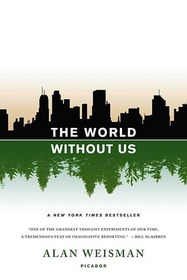Helpful Score: 7
Very informative and enlightening look at how we treat the world we live in and the dangers looming in our future. This book held my attention throughout. Excellent read!!
Helpful Score: 4
From the catalogue: "In A WORLD WITHOUT US, what traces of us would linger, and which would disappear? Weisman writes about which objects from today will vanish; which will become relics and fossils; how our pipes, wires, and cables will be pulverized into an unusual (but mere) line of red rock; why some museums and churches might be the last human creations standing; and how plastic, cast-iron, and radio waves may be our most lasting gifts to the planet.
But of our world currently fare The World Without Us is also about how parts without a human presence (Chernobyl; a Polish old-growth forest; the Korean DMZ) and it looks at the human legacy on Earth, whether fleeting or indelible. Its narrative nonfiction at its finest, taking on an irresistable concept with gravity and a highly-readable touch."
I avoided reading this book because I thought it was another "humans-are-bad-for-the-planet-and-we-should-be-ashamed-we're-even-breathing-its-air" book, but I heard Alan Weisman on a radio interview and was impressed with his enthusiasm for the subject of how fascinating the planet is and, with the hypothetical premise of "what if all the humans disappeared en masse in one day--not disease or war, so there would not be corpses--how would the earth survive (fairly well). No, he doesn't hate humans. He made a point of saying it wasn't a treatise on how we're damaging the planet, but what the effects of our actions are. That may sound contradictory, but his point is that we're humans not monsters and if we see what effect our actions and products we may think and act differently. (If you never hated plastic before, you will now--almost every bit that has ever been produced in the last 60 years since it was found still exists; it won['t go away, although he's sure that there are microbes mutating to be little plastic eaters that way there are microbes to eat just about everything else.) As a recognizable example, he chose New York City. As a lifetime resident I was both appalled and fascinated: The Brooklyn Bridge will last centuries because when it was built no one had built anything like it, had no blueprint, and there were no computers so they packed in lots more stone and steel than would prove necessary. The subways have 24-hour-a-day pumps to keep out the water; when the people disappear there is no one to maintain the pumps and in about 48 hours, the subways flood well above the platform. Wild life from upstate would soon take back Manhattan. He even theorizes over pet dogs and cats--one species would survive, one wouldn't. Then the book expands to discuss current (not hypothetical) situations in other parts of the world. It's gets very intense at times and I found myself needing to switch to fiction or lighter nonfiction, but wanting to go back to it.
But of our world currently fare The World Without Us is also about how parts without a human presence (Chernobyl; a Polish old-growth forest; the Korean DMZ) and it looks at the human legacy on Earth, whether fleeting or indelible. Its narrative nonfiction at its finest, taking on an irresistable concept with gravity and a highly-readable touch."
I avoided reading this book because I thought it was another "humans-are-bad-for-the-planet-and-we-should-be-ashamed-we're-even-breathing-its-air" book, but I heard Alan Weisman on a radio interview and was impressed with his enthusiasm for the subject of how fascinating the planet is and, with the hypothetical premise of "what if all the humans disappeared en masse in one day--not disease or war, so there would not be corpses--how would the earth survive (fairly well). No, he doesn't hate humans. He made a point of saying it wasn't a treatise on how we're damaging the planet, but what the effects of our actions are. That may sound contradictory, but his point is that we're humans not monsters and if we see what effect our actions and products we may think and act differently. (If you never hated plastic before, you will now--almost every bit that has ever been produced in the last 60 years since it was found still exists; it won['t go away, although he's sure that there are microbes mutating to be little plastic eaters that way there are microbes to eat just about everything else.) As a recognizable example, he chose New York City. As a lifetime resident I was both appalled and fascinated: The Brooklyn Bridge will last centuries because when it was built no one had built anything like it, had no blueprint, and there were no computers so they packed in lots more stone and steel than would prove necessary. The subways have 24-hour-a-day pumps to keep out the water; when the people disappear there is no one to maintain the pumps and in about 48 hours, the subways flood well above the platform. Wild life from upstate would soon take back Manhattan. He even theorizes over pet dogs and cats--one species would survive, one wouldn't. Then the book expands to discuss current (not hypothetical) situations in other parts of the world. It's gets very intense at times and I found myself needing to switch to fiction or lighter nonfiction, but wanting to go back to it.
Helpful Score: 3
This starts out exceedingly well, one of the best "first acts" in any science book I've ever read. Unfortunately, it loses a lot of that energy during the middle and the end, as it seems to forget its original vision and become a largely generic environmental text. However, some of the environmental facts presented are amazing and truly shocking.




